Holocaust Memorial Center
| Year: | 2019 |
| Type: | competition entry |
| Award: | 1st prize |
| Location: | Babyn Yar, Kyiv (UKR) |
| Area: | 89.000 m² |
| Scope: | landscape design |
| Architecture: | querkraft architekten zt gmbh |
| Initiated by: | Babyn Yar Holocaust Memorial Center |
The Babyn Yar Holocaust Memorial Center primary mission is to respectfully commemorate the victims of the Babyn Yar tragedy and to promote the humanization of mankind through the memory preservation and study of the history of the Holocaust. The non-governmental fund aims to create a documentation, commemoration and learning center in Kyiv, dedicated to the memory of the massacre of Babyn Yar in the years 1941-1943. The new center will be located on the site of the former canyon named Babyn Yar, where in September 1941 33.771 Jews were shot in just 2 days.

site | maps and aerial photo 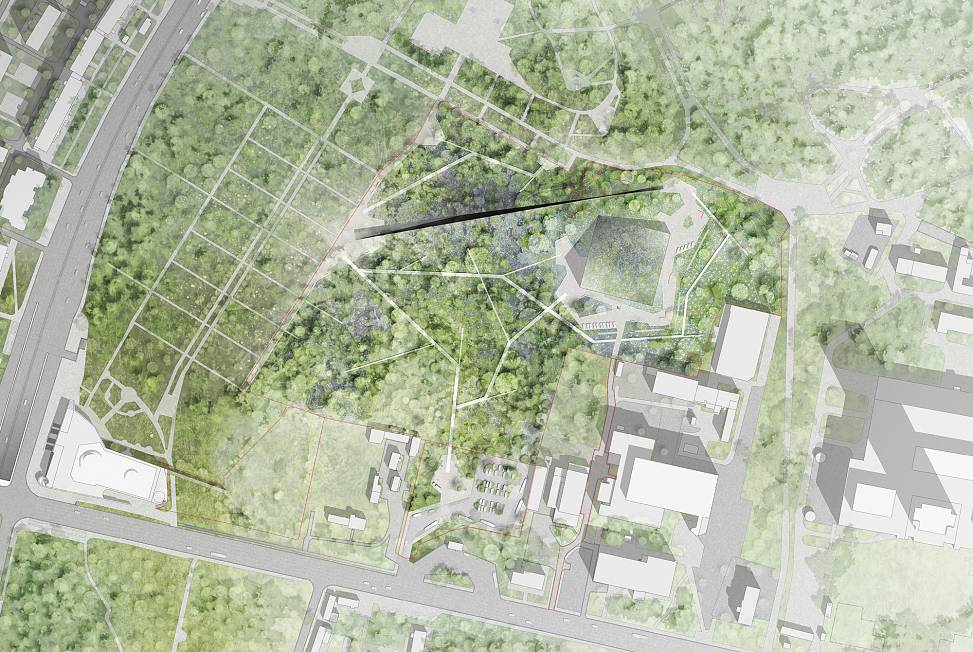
site plan 
concept diagram
Past. Future. Present.
The design redefines the meaning of the site and rearranges its spatial and temporal dimensions. The perception of the visitor is at the center of the design concept at all times. The visitor’s relationship to the past, to the present and to the future is addressed in particular, which is consistently reflected in the spatial configuration of the entire area (see diagram). a wide dramaturgical arc is built, at first picking up the visitors in the present moment and sensitizing them to the site (1). Only then are they led down into the dark abyss of the past (2) and confronted with the tragic historical events (3). Subsequently, the visitors slowly emerge (4) into a bright and inviting space that embraces a hopeful future (5) before being released into their present every day life (6). Essential is the non-linear arrangement of present, past, and future-oriented spaces. Their constant connections give cause for hope and are warnings at the same time.

arrival and departure | diagrams
Landscape
Through the establishment of the BYHMC, the surrounding landscape is freed from a task it has not been able to adequately fulfil in its present form. The superimpositions of visible and, above all, invisible traces and layers of the past do not mediate the history of the place appropriately and hardly do justice to its significance. Now that confrontation and convey as well as future-oriented reappraisal are to be located in the BYHMC, the surrounding landscape can become a peaceful space of memory and contemplation, stimulated and animated by natural growth. Paths virtually floating above the forest ground guide arriving visitors towards the entrance and create a sense of awareness of the vulnerability of the site. The underlying ground level becomes an untouchable, tender blooming veil of colour - dedicated to the dead in their diversity. The forest becomes a living memorial.

floating paths | axonometry & visualization 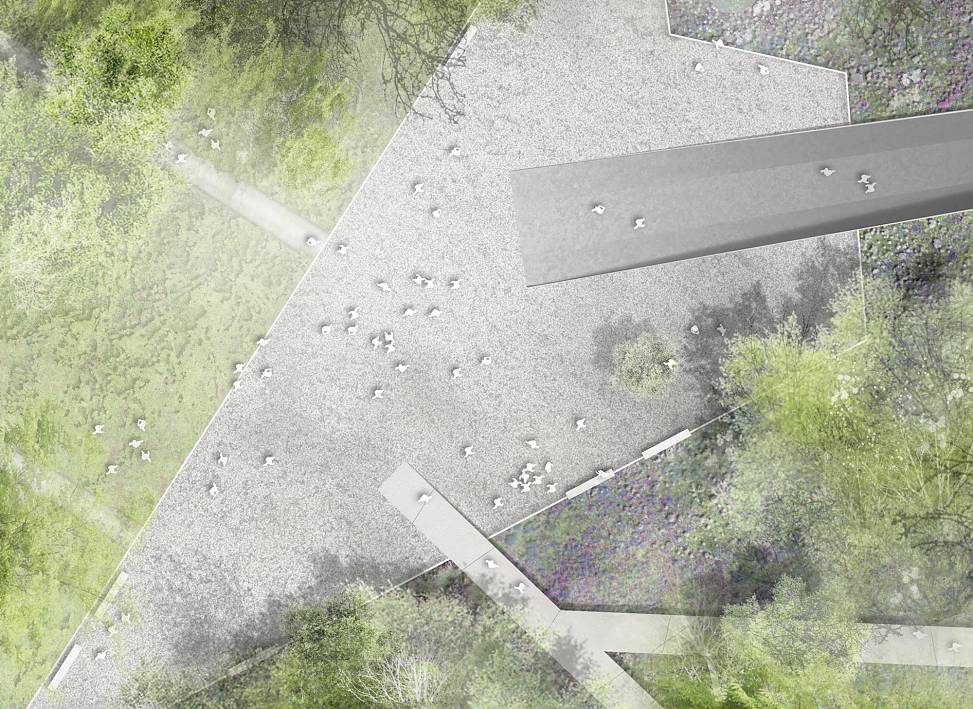
exhibition entrance space 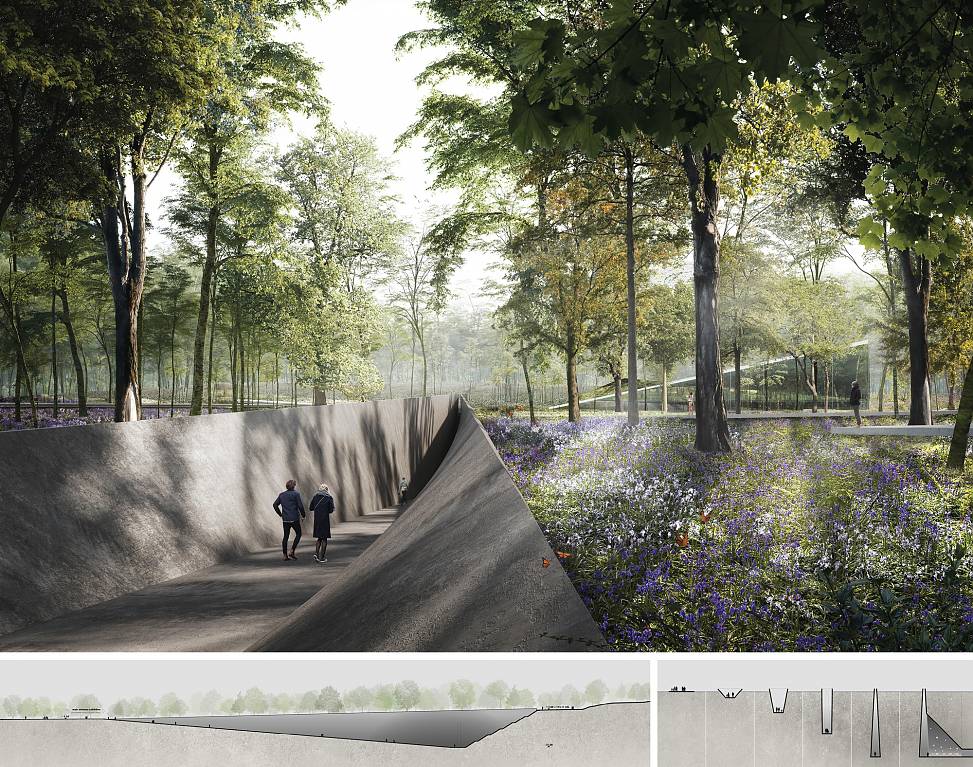
exhibition entrance | rendering © expressiv.at
Intro
The subterranean building is accessed by a 250 meter long incision into the landscape - a walkable sculpture. Beginning as a wide flat surface, the walls of the ramp fold in on themselves and above the visitor. The path leading down can be interpreted in two ways: firstly, as the path taken by the victims to the place of the massacre and secondly, as the unswerving and oblivious blind following of a society into the dark. To begin with the situation seems harmless, the threat then becomes more and more apparent, finally leading to hopelessness and desperation.
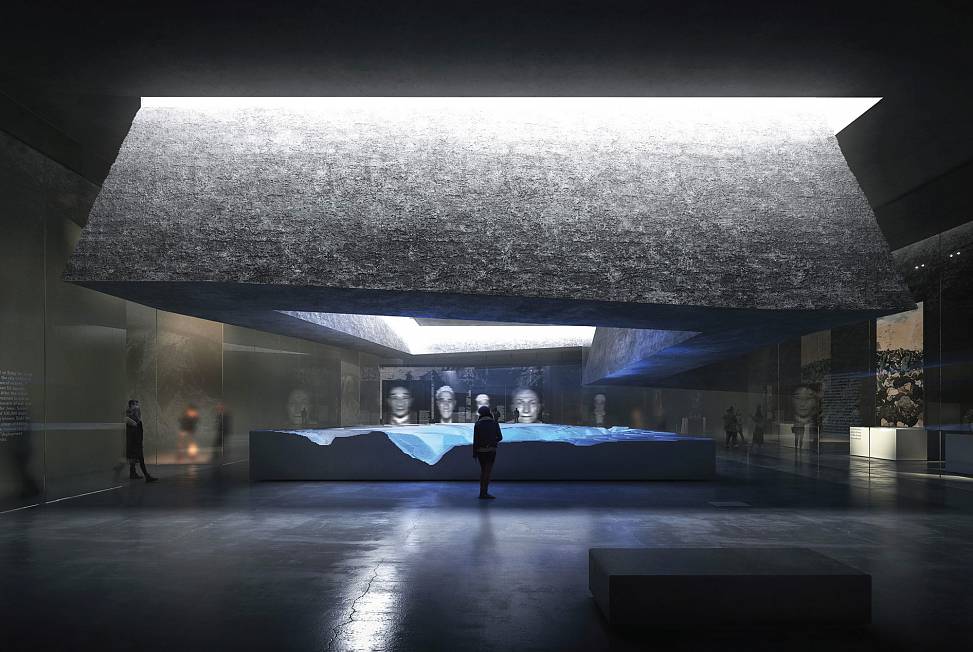
exhibition | rendering © expressiv.at
Confrontation
Once lead down by the ramp and having entered the dark antechamber - a place to regather thoughts, the visitor experiences a direct confrontation with the history in the exhibition. The exhibition space is defined by differentiated spatial situations and emotional lighting guidance. There is a clear visual and acoustical separation from the rest of the building. The flexible customization of lighting and spatial qualities in the exhibition rooms allows for the adaption and incorporation of future research findings, new exhibits and artistic interventions.

building floor plans 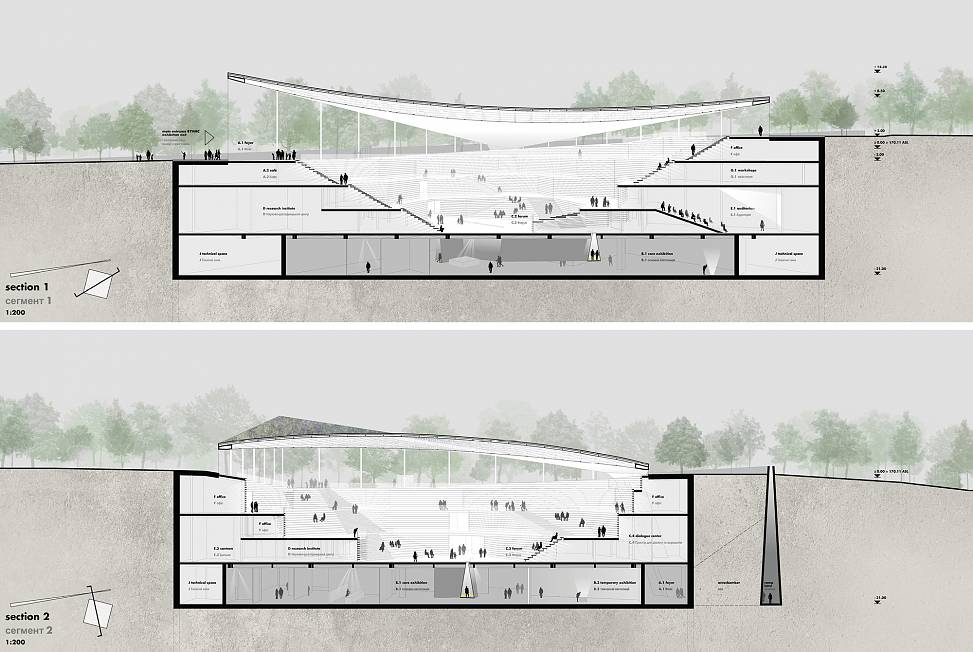
building sections
Outro
Upon completion of the exhibition tour the visitor is brought up by a ramp. Audio and visual installations accompany the visitor on their slow transition into the “democratic space”. The path - leading from the dark exhibition space into the light - is enhanced by a constant growing spatial opening from above, ending in the “democratic space” filled with light.
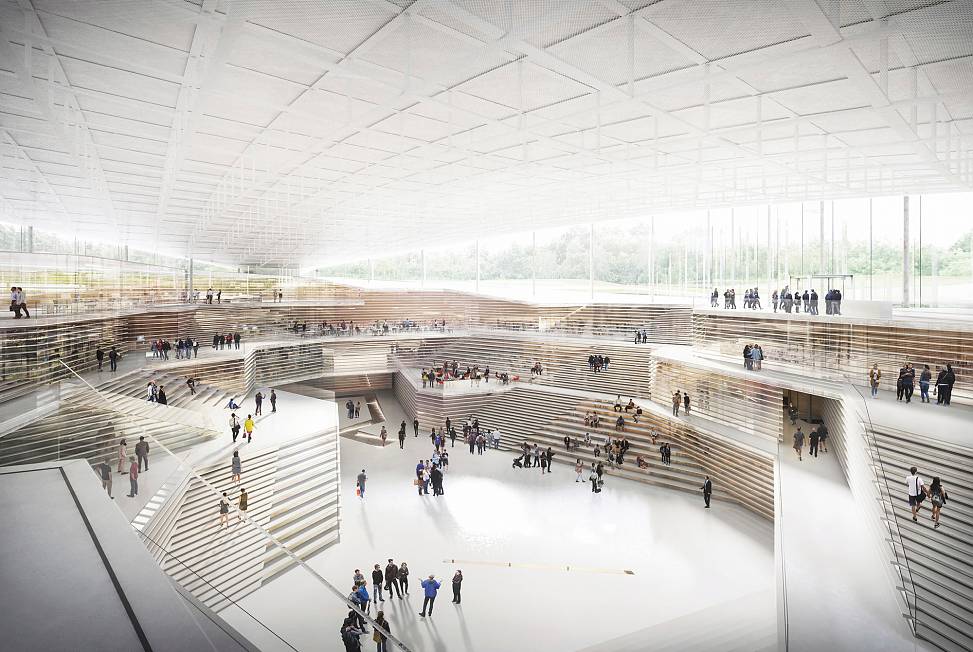
"democratic space" | rendering © expressiv.at
Future
The “democratic space” represents the heart of the building - a bright, positive, open and walkable terraced landscape, accommodating foyer functions, such as a café and a bookstore. Due to its varied form, it provides zones for exchange as well as contemplation and rest. All rooms develop around an informal centre. Different circulation routes are available, which in turn produces common spaces with various qualities. The administrative areas are oriented towards the active atrium above, creating a strong connection between visitors, researchers and employees. At the above end of the interior terraced landscape the hyperbolic paraboloid roof opens up in a generous gesture to release the visitors into the surrounding natural landscape.
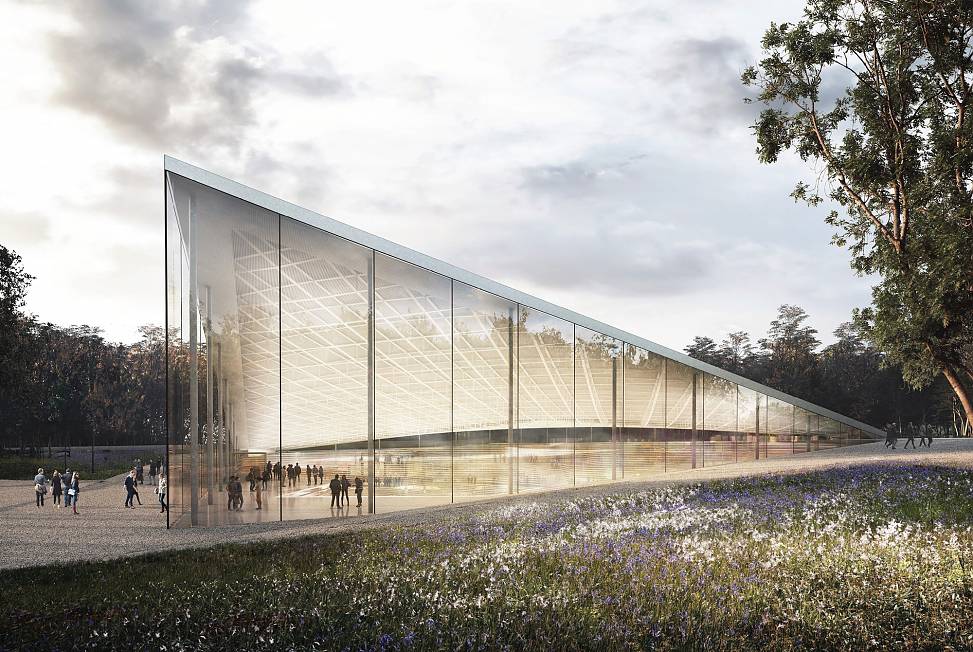
center building | rendering © expressiv.at
Contemplation
The respectful walk through the forest is the final experience of the BYHMC. Sounds and scents of a familiar environment offer visitors leaving the startling exhibition a quiet space to reflect and process their experience before returning to their everyday life. The exiting walk above tender blooming forest grounds might, in its effect, strongly differ from the entering walk. The forest might appear in a different light. And the visitor might ask himself: has the forest changed? Or have I?

"dead end" of floating path
Places of remembrance
The floating paths lead through the forest and over a flower carpet with diverse seasonal aspects and an emphasis on blue, violet and white blossoms. The floating paths are applied as primary and secondary paths. The primary paths establish unmistakable connections to all parts of the site. The secondary paths create „dead ends“ in a both literal and figurative sense. Seating facilities at the end of the secondary paths offer visitors quiet places of reflection and remembrance close to nature and aside the main paths.

entering the historical area of the old jewish cemetery
Jewish Cemetery
The artistic and poetic integration of tombstones and memorial plates into the historical area of the jewish cemetery is an essential part of the proposed project. The historical area east of the center building is an integral part of the landscape and accessible via the floating paths. The visitor is guided through a geometrically precise placement of tombstones and memorial plates. Within the stringent grid of stones some positions remain unfilled - empty spaces that visualize and commemorate the nameless in a both significant and poetic gesture.
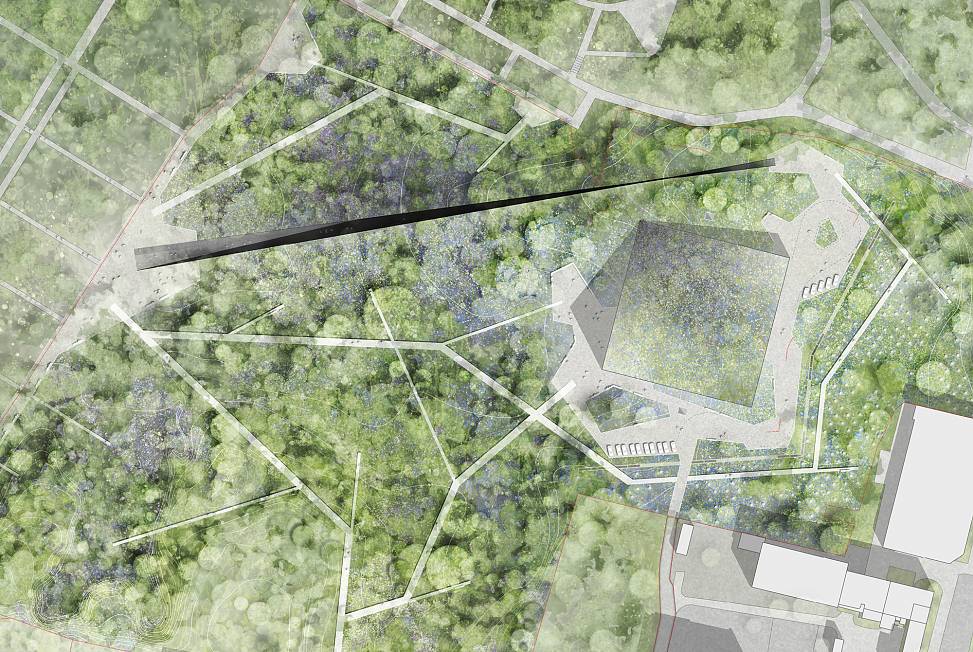
site plan detail
